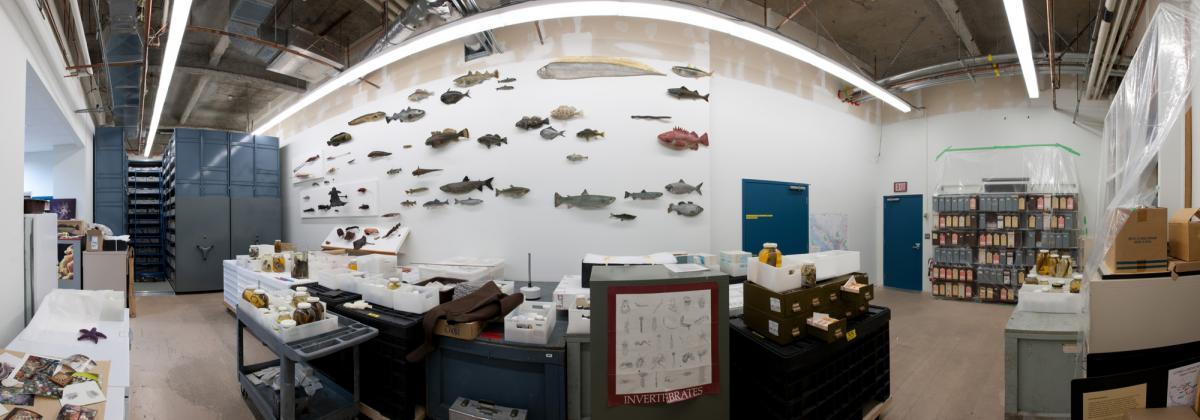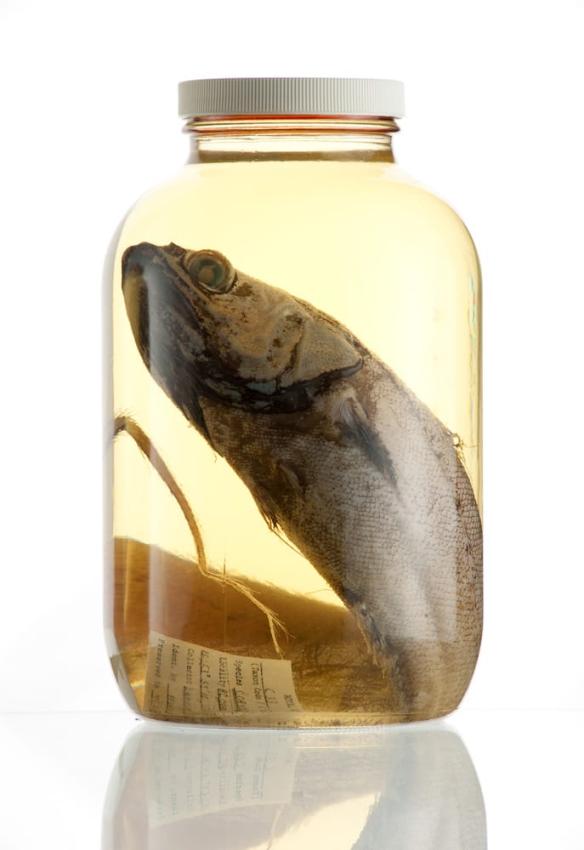
Modernization
Learn more about government’s intention to modernize the museum to protect our historic holdings and provide better access to our collections.


Most people are familiar with the game fish in British Columbia, but not the vast majority of British Columbia’s marine and freshwater vertebrates that are not exploited for human use. Non-game fishes form the foundation for ecological communities, and these organisms cannot be ignored if we hope to understand population dynamics in British Columbia. The Royal BC Museum’s collection contains over 101,861 vertebrate specimens, in a wide range of life-history stages from eggs and newly hatched or neonate animals to fully adult individuals. About 647 species of fishes are represented in the collection, with more added every time researchers get out to survey new areas.
Most fishes are housed in jars ranging from 125 ml up to 2 litres volume; large wet specimens such as sharks and sturgeon are housed in vats. The wet collection also includes cleared and stained fishes which are available for study of skeletal structure. Jars in the collection may house only one specimen, or may be packed with a number of specimens caught at a particular place and time. Each specimen has a label with some collection data and a catalogue number, and specimens are ordered in the collection according to a rough pattern of evolutionary relationships.
This collection contains some type specimens. Type specimens are the best examples of a species at the time a particular species was described. Better specimens may be found years later, but the type specimen designation stays with the original material used to describe a species. There are provisions for designating new types specimens if the originals are lost, but this is the exception rather than common practice.
Type specimens are held in separate cabinets away from the main part of the research material. They do not go on loan to other institutions, and therefore, researchers must come here to examine these high-priority items.
Most vertebrates in the RBCM collection are from British Columbia, but a small number of specimens comes from outside our borders, and serves to exemplify organisms that may arrive here in the future or represent closely-related organisms for comparison. There are also several exotic species in this collection to document the continued presence of species introduced by humans for angling, hunting, farming or from the pet trade. The collection does contain a small proportion of other exotic organisms that today would be rejected since they are not representative of British Columbia (e.g., European minnows). Some specimens not from British Columbia have been offered to other institutions (e.g., mosquitofish from the southern USA).
The vertebrate collection likely was the first established by Jack Fannin when the museum was created to stem the flow of artifacts out of province. Hundreds of new specimens are added each year, including the latest exotic fish species to be found in British Columbia, the weather loach. Additions to the collection come in the form of research specimens, donations and specimens transferred from the Department of Fisheries and Oceans, Ministry of Environment, regional natural resources officers and a wide range of other sources.
Fortunately, there is no backlog to the fish collection save perhaps 30 jars of mixed fishes from samples taken in 2007 and 10 tubs of larger fishes from the deep-water Tanner Crab surveys, most of which are already identified and need only be bottled and added to the collection.
This collection contains a large proportion of sculpins (Family Cottidae), both marine and freshwater; snailfishes (Liparidae); eelpouts (Zoarcidae); and minnows (Cyprinidae). Noteworthy specimens newly added to the collection include an albino Oscar (a South American fish) found in Chemainus in 2011 and 7 jars of weather loaches collected in the Alouette River between 2008 and 2010. These represent fishes released from the pet trade; a Flowerhorn Cichlid (a man-made hybrid in the pet trade that exists nowhere in nature) was also found in 2011 in Kelowna, but to date we have not received this specimen.
In recent years, the emphasis has shifted to the collection of representative exotic species, including examples of fishes from the pet trade that have been released in BC. We also are actively collecting intertidal and deep sea fishes to document the present populations along our coast in anticipation of future changes due to anthropogenic climate alteration. The collection is frequently used by researchers from neighbouring provinces and states, and from around the world for a myriad of projects ranging from basic ecology, anatomy and systematics to genetic analyses.
The vertebrate collection's greatest limitation is space to cover all major taxonomic groups. We will need additional room for at least another 1000 specimens in the next few years. While jars of fishes are housed on compact shelving, the collection shares space with the marine and freshwater invertebrates, and the shelves are nearly full with little room for expansion.
Game fishes are under-represented in the collection, in part because of permitting processes in British Columbia. Survey permits usually do not include game fishes such as lingcod, rockfish, salmon and sturgeon—in recent years we have received only a few of these fishes as vouchers from DNA barcoding projects. Commercially exploited species should be collected and added to the museum collections during survey sampling to facilitate research and understanding of species' ranges into the future, and prevent chronological gaps within species.
As with all vertebrate groups, the existing collection focuses on organisms in the southern end of the province. We have many specimens from southern Vancouver Island, the Fraser River delta, and the Okanagan region, and comparatively few from the interior portions of the Fraser drainage, the Yukon drainage and the Mackenzie drainage. The collection also has few specimens from the northern coast and Haida Gwaii (formerly known as the Queen Charlotte Islands), primarily due to the expense of accessing these locations.
By necessity, the vertebrates collection is biased towards smaller animals because of space limitations and preparation. We haven't the space, staff or lab equipment to prepare large sharks, rays, sturgeon and tuna. The present complement of wet-collection vats is nearly full, and we require more vats and cabinets to allow for collection expansion.
Recent
Recent collecting effort has focused on intertidal fishes along the BC coast from Prince Rupert south to Vancouver Island thanks to research trips and cooperative work with the Department of Fisheries and Oceans. These collections are important for documenting what species are here today, to serve as reference in the event of any potential changes to the fauna in the near future. Collections also have been done in the Similkameen River and a few localities on the lower mainland to focus on exotic species introductions (a global problem) and to collect dace for systematics research.
Future
Survey permits to collect fishes tend to be difficult to obtain. Continued surveys are required to keep pace with changes in vertebrate populations, detect the presence of new exotics or expansion of the range of exotic species, and keep track of changes to native species in this province—especially the non-game fishes, which tend to be overlooked. In an environment already heavily impacted by humans, it is difficult to justify collecting when species are already declining compared to historical levels, but we cannot protect what we do not understand, and we cannot understand that which we do not examine. Recovery of specimens from researchers and biological consultants is critical to maintaining a constant flow of specimens into the collection for future research projects because we cannot predict what future researchers will study.
The collection's priorities include:
Multi-staff sampling trips every 5 years will be really useful to get routine collecting effort across different regions of BC on a regular basis to limit temporal as well as geographic gaps in the collection. We also will continue to develop and maintain relationships with outside parties and the general public to ensure a continual flow of specimens and let people know the Royal BC Museum still is collecting and preserving Natural History specimens.
With the increasing popularity of genetics research, the Royal BC Museum receives frequent requests for tissue samples. New −80°C freezers installed in the wet collection in 2011 allow us to increase our relevance to the research community because tissue samples now can be taken and preserved. New specimens (if not already fixed in formalin) will have a tissue sample taken prior to fixation for molecular research, as well as a whole body fixed in formaldehyde for morphological research.
Government staff or contractors/consultants that collect specimens as reference material and vouchers should send their material to the Royal BC Museum. The museum represents a stable repository for specimens for future verification of identification and research. The museum also is actively soliciting specimens from the general public, even though collections near urban environments bias the collection to places frequented by humans. These specimens, however, are valuable in that they document our impact on the environment. Good quality specimens should be forwarded to the Royal BC Museum as records of mortality in BC.
The curator overseeing all vertebrate collections has a background researching fishes, amphibians and reptiles. Since 2008, the vertebrates collection has received 14 lots of fishes from outside sources, including 2 large survey collections containing hundreds of specimens. Each lot may contain multiple specimens needing preparation or preservation.
Researchers are welcome to examine the collections by contacting the appropriate curator and making arrangements with the collections manager. Please give as much notice as possible. You may contact museum staff by e-mail, letter or phone. We will want to know the expected dates of your visit, the specimens you want to examine and your equipment needs (e.g., a microscope). Collection access is between 9:00 AM to 4:30 PM, Monday to Friday, unless otherwise arranged with the curator or collection manager. Requests for loans of specimens must go through the collection manager.